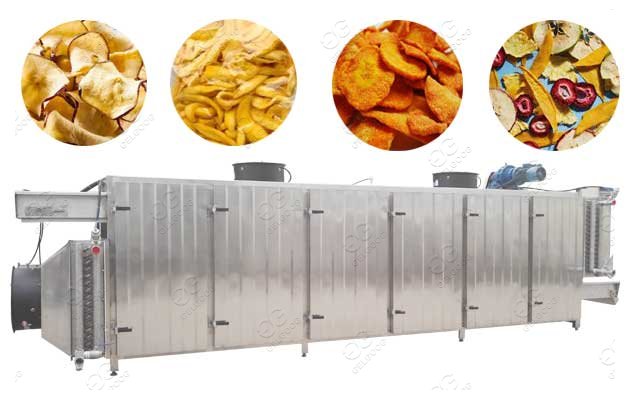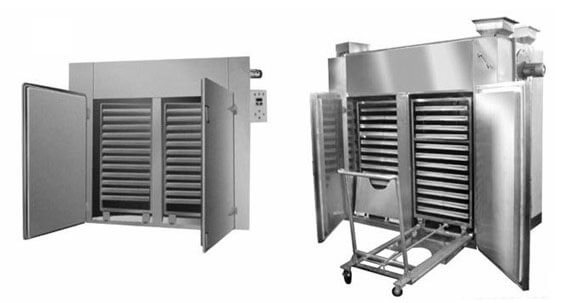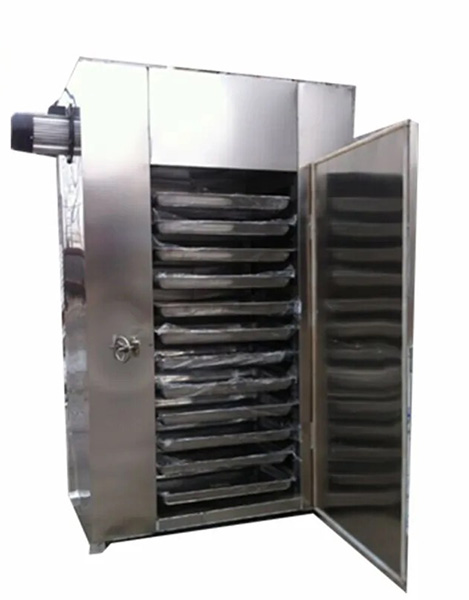
Content Menu
● Introduction
● The Importance of Fruit Drying in Modern Food Processing
>> How Industrial Fruit Dryer Machines Work
● Types of Industrial Fruit Dryer Machines
>> 1. Tray Dryers
>> 2. Tunnel Dryers
>> 3. Spray Dryers
>> 4. Freeze Dryers
● Key Features to Look for in an Industrial Fruit Dryer Machine
● The Impact of Industrial Fruit Dryer Machines on the Food Industry
>> 1. Increased Productivity
>> 2. Improved Product Quality
>> 3. Expanded Product Range
>> 4. Reduced Seasonality
>> 5. Minimized Food Waste
● Innovations in Industrial Fruit Dryer Machine Technology
>> 1. Smart Sensors and IoT Integration
>> 2. Energy-Efficient Heat Pumps
>> 3. Hybrid Drying Systems
>> 4. Pulsed Electric Field (PEF) Pre-treatment
● Choosing the Right Industrial Fruit Dryer Machine for Your Needs
● Best Practices for Operating Industrial Fruit Dryer Machines
● The Future of Industrial Fruit Drying
● Conclusion
● Frequently Asked Questions
>> 1. What are the main advantages of using an industrial fruit dryer machine over traditional drying methods?
>> 2. How do I determine the right capacity for an industrial fruit dryer machine for my business?
>> 3. What are the energy requirements for running an industrial fruit dryer machine?
>> 4. How do I maintain the quality of fruits during the drying process?
>> 5. What are the key maintenance requirements for an industrial fruit dryer machine?
Introduction
In the ever-evolving world of food processing and preservation, industrial fruit dryer machines have emerged as game-changers. These sophisticated pieces of equipment have revolutionized the way we preserve fruits, offering unparalleled efficiency, consistency, and quality. Whether you're a small-scale farmer looking to expand your product line or a large food processing company aiming to streamline operations, understanding the ins and outs of industrial fruit dryer machines is crucial.
The Importance of Fruit Drying in Modern Food Processing
Fruit drying is an ancient preservation technique that has stood the test of time. However, with the advent of industrial fruit dryer machines, this process has been elevated to new heights of efficiency and effectiveness. These machines offer numerous benefits:
1. Extended shelf life of fruits
2. Preservation of nutritional value
3. Reduction of food waste
4. Creation of value-added products
5. Year-round availability of seasonal fruits

How Industrial Fruit Dryer Machines Work
At its core, an industrial fruit dryer machine operates on a simple principle: the controlled removal of moisture from fruits. However, the technology behind these machines is anything but simple. Modern industrial fruit dryer machines utilize advanced heat pump technology, precise temperature and humidity controls, and efficient air circulation systems to ensure optimal drying conditions.
The process typically involves the following steps:
1. Preparation: Fruits are washed, sorted, and sometimes pre-treated (e.g., blanching or sulfuring) to enhance the drying process.
2. Loading: The prepared fruits are evenly spread on trays or conveyor belts within the dryer.
3. Drying: Hot air is circulated through the machine, gradually removing moisture from the fruits.
4. Monitoring: Advanced sensors continuously monitor temperature, humidity, and air flow to ensure optimal drying conditions.
5. Cooling: Once the desired moisture content is reached, the dried fruits are cooled to prevent condensation.
6. Packaging: The final product is packaged for storage or distribution.
Types of Industrial Fruit Dryer Machines
The market offers a variety of industrial fruit dryer machines, each suited to different needs and scales of operation:
1. Tray Dryers
Tray dryers are among the most common types of industrial fruit dryer machines. They consist of multiple trays stacked vertically within an insulated chamber. Hot air is circulated through the chamber, efficiently drying the fruits on each tray.
2. Tunnel Dryers
Tunnel dryers are ideal for continuous, large-scale operations. Fruits are placed on trays or conveyor belts that move slowly through a long tunnel. Hot air is blown through the tunnel, drying the fruits as they progress.
3. Spray Dryers
Spray dryers are used primarily for liquid fruit products. The fruit juice or puree is atomized into fine droplets and exposed to hot air, instantly drying the particles into a powder form.
4. Freeze Dryers
Freeze dryers, while more expensive, offer superior quality preservation. The fruits are frozen and then placed in a vacuum chamber where the ice sublimates directly into vapor, leaving behind perfectly preserved, crisp dried fruits.

Key Features to Look for in an Industrial Fruit Dryer Machine
When selecting an industrial fruit dryer machine, several key features should be considered:
1. Capacity: Ensure the machine can handle your required volume of fruits.
2. Energy Efficiency: Look for machines with heat recovery systems and efficient insulation.
3. Temperature Control: Precise temperature control is crucial for maintaining fruit quality.
4. Humidity Control: The ability to regulate humidity levels can significantly impact drying time and quality.
5. Air Flow: Efficient air circulation ensures even drying across all trays or belts.
6. Material Quality: Opt for machines made with food-grade stainless steel for durability and hygiene.
7. Automation: Advanced control systems can streamline operations and ensure consistency.
8. Versatility: Some machines can handle various fruits and even vegetables, increasing their utility.
The Impact of Industrial Fruit Dryer Machines on the Food Industry
The adoption of industrial fruit dryer machines has had a profound impact on the food industry:
1. Increased Productivity
These machines can process large volumes of fruits quickly and efficiently, significantly boosting productivity for food processors.
2. Improved Product Quality
With precise control over drying conditions, industrial fruit dryer machines produce consistently high-quality dried fruits with optimal texture, color, and flavor retention.
3. Expanded Product Range
Food companies can now offer a wider variety of dried fruit products, including exotic fruits that were previously difficult to preserve.
4. Reduced Seasonality
By efficiently drying fruits at their peak ripeness, these machines allow for year-round availability of seasonal fruits.
5. Minimized Food Waste
Surplus fruits that might otherwise go to waste can be dried and preserved, reducing overall food waste in the supply chain.
Innovations in Industrial Fruit Dryer Machine Technology
The field of industrial fruit drying is constantly evolving, with new innovations enhancing efficiency and product quality:
1. Smart Sensors and IoT Integration
Modern industrial fruit dryer machines are increasingly equipped with smart sensors that can monitor and adjust drying conditions in real-time. These sensors can be connected to the Internet of Things (IoT) platforms, allowing for remote monitoring and control.
2. Energy-Efficient Heat Pumps
Advanced heat pump technology is being incorporated into industrial fruit dryer machines, significantly reducing energy consumption while maintaining optimal drying conditions.
3. Hybrid Drying Systems
Some manufacturers are developing hybrid systems that combine different drying technologies (e.g., convection and freeze-drying) to optimize the drying process for different types of fruits.
4. Pulsed Electric Field (PEF) Pre-treatment
PEF technology is being explored as a pre-treatment method to enhance the drying process, potentially reducing drying time and improving product quality.
Choosing the Right Industrial Fruit Dryer Machine for Your Needs
Selecting the appropriate industrial fruit dryer machine is crucial for the success of your operation. Consider the following factors:
1. Scale of Operation: Determine your current and projected production volume to choose a machine with the right capacity.
2. Types of Fruits: Different fruits may require different drying conditions. Ensure the machine can handle the varieties you plan to process.
3. Energy Costs: Consider the long-term energy consumption of the machine, as this can significantly impact operating costs.
4. Space Constraints: Industrial fruit dryer machines come in various sizes. Ensure you have adequate space for installation and operation.
5. Budget: While it's important to stay within budget, consider the long-term return on investment rather than just the initial cost.
6. Maintenance and Support: Look for manufacturers that offer reliable after-sales support and easy access to spare parts.
Best Practices for Operating Industrial Fruit Dryer Machines
To get the most out of your industrial fruit dryer machine, follow these best practices:
1. Regular Maintenance: Keep the machine clean and well-maintained to ensure optimal performance and longevity.
2. Proper Loading: Ensure fruits are evenly spread on trays or belts to allow for uniform drying.
3. Pre-treatment: Consider pre-treating fruits (e.g., blanching or sulfuring) to enhance the drying process and final product quality.
4. Monitoring: Regularly check and calibrate temperature and humidity sensors to maintain precise control over drying conditions.
5. Energy Management: Implement energy-saving practices, such as scheduling drying operations during off-peak hours.
6. Staff Training: Ensure all operators are properly trained in the use and maintenance of the machine.
7. Quality Control: Implement a robust quality control system to consistently produce high-quality dried fruits.
The Future of Industrial Fruit Drying
As technology continues to advance, we can expect to see further innovations in industrial fruit dryer machines:
1. Artificial Intelligence: AI-powered systems may optimize drying processes in real-time based on fruit characteristics and environmental conditions.
2. Sustainable Energy Integration: Future machines may incorporate renewable energy sources like solar or biomass to reduce environmental impact.
3. Nanotechnology: Nanocoatings may be developed to enhance the drying process or improve the shelf life of dried fruits.
4. Customization: Machines may offer more flexibility in customizing drying profiles for specific fruit varieties or desired end products.
Conclusion
Industrial fruit dryer machines have transformed the landscape of fruit preservation, offering unprecedented efficiency, quality, and scalability. As the demand for dried fruits continues to grow globally, these machines will play an increasingly crucial role in meeting market needs while minimizing food waste and preserving nutritional value.
Whether you're a small-scale producer looking to expand your product line or a large food processing company aiming to optimize operations, investing in the right industrial fruit dryer machine can be a game-changer for your business. By understanding the technology, considering your specific needs, and staying abreast of innovations in the field, you can harness the full potential of these remarkable machines to drive your success in the competitive world of food processing and preservation.

Frequently Asked Questions
1. What are the main advantages of using an industrial fruit dryer machine over traditional drying methods?
Answer: Industrial fruit dryer machines offer several advantages over traditional methods:
- Faster drying times, increasing productivity
- More consistent results in terms of moisture content and quality
- Better preservation of nutrients and flavor
- Ability to process larger volumes of fruit
- Greater control over drying conditions, reducing the risk of spoilage
- Year-round operation, independent of weather conditions
2. How do I determine the right capacity for an industrial fruit dryer machine for my business?
Answer: To determine the right capacity:
- Calculate your current daily or weekly fruit processing volume
- Consider your projected growth over the next 3-5 years
- Factor in seasonal fluctuations in fruit availability
- Consider the types of fruits you'll be drying, as different fruits have different drying times
- Allow for some extra capacity to accommodate unexpected demand or new product lines
It's often wise to choose a machine with slightly more capacity than your current needs to allow for future growth.
3. What are the energy requirements for running an industrial fruit dryer machine?
Answer: Energy requirements can vary significantly depending on the size and type of the machine. However, most industrial fruit dryer machines are designed to be energy-efficient. Key factors include:
- The machine's capacity and size
- The type of heating system (e.g., electric, gas, or heat pump)
- The desired drying temperature and time
- The initial moisture content of the fruits
Modern machines often incorporate energy-saving features like heat recovery systems and efficient insulation. It's best to consult with the manufacturer for specific energy consumption data for the model you're considering.
4. How do I maintain the quality of fruits during the drying process?
Answer: To maintain fruit quality during drying:
- Ensure fruits are properly washed and sorted before drying
- Consider pre-treatments like blanching or sulfuring for certain fruits
- Maintain consistent and appropriate temperature and humidity levels
- Ensure even air circulation throughout the drying chamber
- Monitor the drying process regularly and adjust parameters as needed
- Avoid over-drying, which can negatively impact texture and flavor
- Cool dried fruits properly before packaging to prevent condensation
5. What are the key maintenance requirements for an industrial fruit dryer machine?
Answer: Regular maintenance is crucial for optimal performance:
- Clean the machine thoroughly after each use to prevent residue buildup
- Regularly inspect and clean air filters to ensure proper air circulation
- Check and calibrate temperature and humidity sensors periodically
- Lubricate moving parts as recommended by the manufacturer
- Inspect electrical connections and components for any signs of wear
- Schedule professional maintenance checks at intervals recommended by the manufacturer
- Keep detailed maintenance logs to track performance and identify potential issues early












